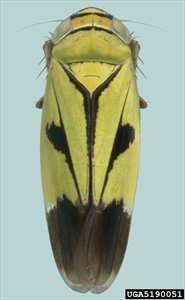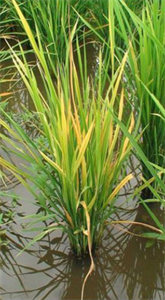Rice green leafhopper
Pacific Pests, Pathogens, Weeds & Pesticides - Online edition
Pacific Pests, Pathogens, Weeds & Pesticides
Rice green leafhopper (417)
Nephotettix nicropictus; there are several other Nephotettix green leafhopper species that feed on rice, e.g., Nephotettix malayanus and Nephotettix virescens.
Asia, Africa (Cameroon), Oceania. It is recorded from Australia, Fiji, Guam, Federated States of Micronesia, Palau, and Papua New Guinea.
Rice and wild grasses and sedges.
The green leafhopper is more common in lowland rainfed and irrigated wetland rice than in upland rice. Nymphs and adults do the damage, directly by sucking the sap of rice plants, creating white patches on the tillers, and causing wilting and, if the population is high enough, they cause 'hopperburn' - a yellowing, browning and death of the plants. Indirectly, damage is caused by the green leafhopper spreading virus diseases, e.g., Rice tungro bacilliform virus, Rice tungro spherical virus, and others. Note that tungro viruses are not present in Pacific island countries; nearest country is Irian Jaya.
Eggs are white, banana-shaped, laid in groups of about 15 into the leaf sheath or the midribs. The nymphs are yellow at first, turning light brown and then near black at maturity. The adults have two black spots, extending to the tips of the forewings, black tips to the wings, and black around the margins of the pronotum (extension from the head over the thorax) (Photo 1). The black bands on the head are less obvious in females.
Female lefthoppers disperse as the crop matures, but they are not strong fliers, traveling only about 1 km. Large migrations do not occur.
Rarely are green leafhoppers in sufficient numbers to cause severe damage directly; they feeds more on grassy weeds than on rice; however, they transmit virus diseases to rice, even though they are considered to be less efficient in transmitting viruses than another green leafhopper, Nephotettix virescens.
Look for the black spots on the centres and tips of the wings, and, also, three parallel bands across the head, best seen from above. An entirely green form also exists, but black lines on the head distinguish it from other leafhoppers. Note, that regrowth of plants after harvest is a good time to determine the presence of disease.
NATURAL ENEMIES
There are a large number of parastoids and predators that attack all stages of the green leafhopper life cycle. As long as insecticides are not used, populations of this pest are usually under control by natural enemies. However, virus infection may still occur. Infection is often early in the crop, at times when parasitoids and predators are only beginning to increase, and numbers too small to control populations to the level required to prevent spread of viruses.
CULTURAL CONTROL
Before planting:
- Try to synchronise planting in any area so that crops do not overlap, to prevent pest populations moving from harvested to standing crops.
- Try to ensure that there is a rice-free period, and this coincides with the dry season (if there is one), so that hopper populations are low. During this time hoppers will lose the virus and their ability to infect. The ability of green leafhoppers to transmit tungro viruses is lost within 2 weeks. The virus is 'semi-persistent'.
- Avoid early infection by virus diseases: in irrigated systems. It is good practice to make nurseries away from rice fields and possible sources of infection.
- Plant when local knowledge suggests that crops will not coincide with seasonal peaks of leafhopper populations.
- Try planting older (>3 week-old) seedlings to delay the time that plants are exposed to infection in the vegetative stage.
During growth:
- Do not apply excessive amounts of nitrogen: follow local recommendations.
- Weed; remove grasses from around the fields, as these may be sources of virus.
After harvest:
- Monitor ratoon crops for virus disease. If present, establish new nurseries away from infected fields. Preferably, plough the land, turning the stubble into the soil.
- Rotate with other crops in the dry season: plant maize, soybean or peanut. Alternatively, fallow the land between rice crops.
RESISTANT VARIETIES
Most modern varieties released in Asia have resistance against Nephotettix virscens, and so they will be useful against Nephotettix nigropictus, too. Interestingly, resistant varieties force a change in feeding of the leafhopper from phloem to xylem, and as the virus is concentrated in the phloem, fewer leafhoppers are infected.
CHEMICAL CONTROL
In Fiji, acephate and diazinon are recommended, but these insecticides should be used sparingly, and only when outbreaks of the leafhopper are likely to cause damage, which is relatively rare. Insecticides are more likely to result in the destruction of parasitoids and predators and cause increases of OTHER insects, e.g., the brown planthopper, and result in a rapid increase (‘resurgence’) of populations, leading to hopperburn.
Use neem as an alternative insecticide; it is effective and less harmful to natural enemies than most commercial insecticides.
____________________
When using a pesticide, always wear protective clothing and follow the instructions on the product label, such as dosage, timing of application, and pre-harvest interval. Recommendations will vary with the crop and system of cultivation. Expert advice on the most appropriate pesticide to use should always be sought from local agricultural authorities.
AUTHOR Grahame Jackson
Information from CABI Plantwise Knowledge Bank (https://www.plantwise.org/KnowledgeBank/datasheet/36200); and Plant-sucking pests - green leafhoppers. (https://www.flickr.com/photos/ricephotos/6676383521/in/photostream/); and from Catindig J (undated) Rice leaffolder, Green leafhopper. Rice Knowledge Bank. IRRI.(http://www.knowledgebank.irri.org/training/fact-sheets/pest-management/insects/item/green-leafhopper). Photo 1 Nephotettix nigropictus Natasha wright, Cook's Pest Control, Bugwod.org. Photo 2&3 Bhusal K et al. (2019) A review of rice Tungro virus in Nepal. Journal of Plant Sciences and Crop Protection. Volume 2(1).
Produced with support from the Australian Centre for International Agricultural Research under project HORT/2016/185: Responding to emerging pest and disease threats to horticulture in the Pacific islands, implemented by the University of Queensland and the Secretariat of the Pacific Community.






